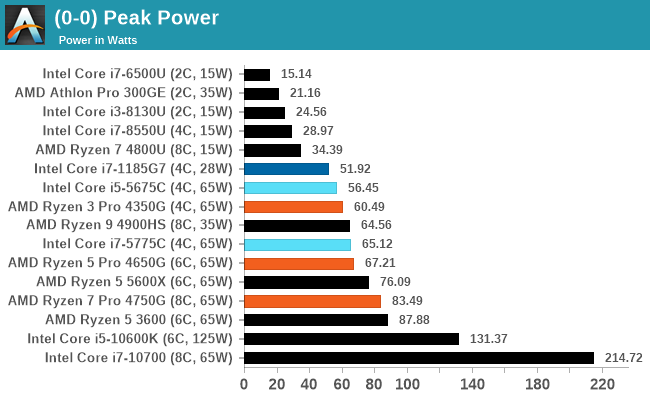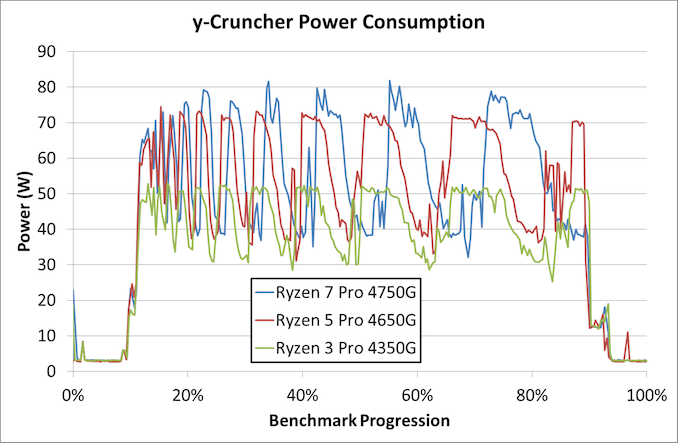Testing The World’s Best APUs: Desktop AMD Ryzen 4750G, 4650G and 4350G
by Dr. Ian Cutress on December 16, 2020 10:30 AM ESTPower Consumption
The nature of reporting processor power consumption has become, in part, a dystopian nightmare. Historically the peak power consumption of a processor, as purchased, is given by its Thermal Design Power (TDP, or PL1). For many markets, such as embedded processors, that value of TDP still signifies the peak power consumption. For the processors we test at AnandTech, either desktop, notebook, or enterprise, this is not always the case.
Modern high performance processors implement a feature called Turbo. This allows, usually for a limited time, a processor to go beyond its rated frequency. Exactly how far the processor goes depends on a few factors, such as the Turbo Power Limit (PL2), whether the peak frequency is hard coded, the thermals, and the power delivery. Turbo can sometimes be very aggressive, allowing power values 2.5x above the rated TDP.
AMD and Intel have different definitions for TDP, but are broadly speaking applied the same. The difference comes to turbo modes, turbo limits, turbo budgets, and how the processors manage that power balance. These topics are 10000-12000 word articles in their own right, and we’ve got a few articles worth reading on the topic.
- Why Intel Processors Draw More Power Than Expected: TDP and Turbo Explained
- Talking TDP, Turbo and Overclocking: An Interview with Intel Fellow Guy Therien
- Reaching for Turbo: Aligning Perception with AMD’s Frequency Metrics
- Intel’s TDP Shenanigans Hurts Everyone
In simple terms, processor manufacturers only ever guarantee two values which are tied together - when all cores are running at base frequency, the processor should be running at or below the TDP rating. All turbo modes and power modes above that are not covered by warranty. Intel kind of screwed this up with the Tiger Lake launch in September 2020, by refusing to define a TDP rating for its new processors, instead going for a range. Obfuscation like this is a frustrating endeavor for press and end-users alike.
However, for our tests in this review, we measure the power consumption of the processor in a variety of different scenarios. These include full AVX2/AVX512 (delete as applicable) workflows, real-world image-model construction, and others as appropriate. These tests are done as comparative models. We also note the peak power recorded in any of our tests.
First up is our image-model construction workload, using our Agisoft Photoscan benchmark. This test has a number of different areas that involve single thread, multi-thread, or memory limited algorithms.
Each of our three processors here seems to approach different steady state power levels for the different areas of the benchmark.
- The 8-core is around 65 W in the first stage, and more around 48 W in the second stage.
- The 6-core is around 51 W in the first stage, and more around 38 W in the second stage.
- The 4-core is around 36 W in the first stage, and more around 30 W in the second stage.
The fact that the difference between each of the processors is 14-15 W in the first stage would go a little to suggesting that we're consuming ~7 W per core in this part of the test, which is strictly multi-threaded. However when it moves more into variable threaded loading, all three CPUs are well below the TDP levels.
The second test is from y-Cruncher, which is our AVX2/AVX512 workload. This also has some memory requirements, which can lead to periodic cycling with systems that have lower memory bandwidth per core options.
The y-Cruncher test is a little different, as we're mostly concerned about peaks. All three CPUs have a TDP rating of 65 W, however the 8-core here breaches 80 W, the 6-core is around 72 W, and the only processor below that TDP value is the quad core Ryzen 3.
For absolute peak power across all of our tests:

For absolute instanteous peak power, each of the Ryzen R4000 APUs does what was expected - with the Ryzen 7 hitting the socket limit for 65 W processors.












104 Comments
View All Comments
Rudde - Wednesday, December 16, 2020 - link
The lowest resolutions are to remove any gpu bottleneck. It's to measure cpu performance, not igpu performance.ozzuneoj86 - Thursday, December 17, 2020 - link
Why would they remove the GPU bottleneck on the Integrated Graphics test page? Isn't the whole point of that page to test the IGP performance?No one buys a new computer to play at 1080P at 19fps OR to play at 480x360 at 70fps. Just show the most realistically playable setting for a given game. For most that'd be 1280x720 or 1366x768. If it can't break 30fps at those settings, most people will simply not play a game, or they may drop it to 1024x768 or some other somewhat common resolution. They used reasonably resolutions for some tests, I just don't get why they used 360P and 1080P on others, when the results were obviously not going to reflect anything that anyone would ever actually use the IGP for.
I feel bad, because this site is one of the few left that bother to do detailed written reviews like this (...bye Techreport), I just don't understand the choice of tests over the last several years.
erotomania - Wednesday, December 23, 2020 - link
Exactly, Joe. Exactly. Maybe small rodents make a comeback one day, although the chances are approaching zero.zakelwe - Wednesday, December 16, 2020 - link
How come Anandtech are posting this rather than discrete graphics reviews such as Nvidia 3xxx series and Amd 6xxx ?What is going on with your once great site ?
Rudde - Wednesday, December 16, 2020 - link
The gpu testing is done in California and this is done in the UK. Obviously they have a lot of trouble in California (they've mentioned the wildfires).quorm - Wednesday, December 16, 2020 - link
Lol29a - Thursday, December 17, 2020 - link
This is really the excuse they are using.lmcd - Friday, December 18, 2020 - link
If you've ever dealt with PG&E you'd immediately recant, and offer sacrifice to whatever responsible deity protected you from their incompetency.29a - Thursday, December 17, 2020 - link
Anand sold it and it went to shit with terrible articles that could be good like this one.Qasar - Friday, December 18, 2020 - link
29a. if you are that un happy with AT, WHY do you keep coming here and what seems to be, wasting your time ? or do you just come here to whine and complain ?